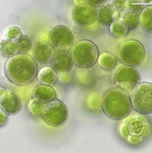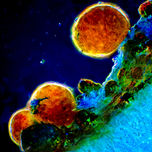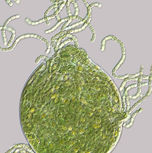- Off to the Desert! -
- Patrick Jung
- 8. Dez. 2020
- 3 Min. Lesezeit
As a young scientist, it is rare to receive several years of funding from the German Research Foundation (DFG) for new research projects in connection with one's own position, but this special recognition has now been bestowed upon me with my research project 'Grit Life'. My work at the University of Applied Sciences Kaiserslautern will therefore continue to focus on the research of a unique microbial community, the so-called Grit Crust in the coastal Atacama Desert in Chile.

Since 2016, I‘m doing research on green algae, cyanobacteria and lichens, which succeed in surviving in the oldest and driest desert on earth, the Atacama Desert in Chile. Strong temperature and radiation fluctuations as well as fog and dew as the only regular sources of water make the living conditions in this barren and extreme landscape very difficult. As a result, only a few specially adapted plants such as euphorbias and cacti can survive in the immediate vicinity of the coast - at least that is how it was long thought. Already during our first field trips we spotted large, blackish appearing marks on the ground, which is actually rather reddish-white. However, detailed observations by our group of biologists, soil scientists, geographers and climate researchers quickly revealed that the dark color was caused by microorganisms that colonize small quartz stones about 6 mm in size and are blackish in dry condition. From there, I dealt extensively with this previously unknown new community of algae, lichens and fungi. We could already show that this community termed 'Grit Crust', is closely adapted to the cyclically occurring fog water input, which fuels the photosynthesis of the organisms and thus also initiates biological weathering processes. The latter lead over longer periods of time to the decomposition of the already small-grained rock to the enrichment of the fine soil material as well as to the initial soil formation on landscape level.

With these and numerous other research contents around algae, lichens and fungi from the Atacama desert and other extreme locations on earth such as Antarctica, I was able to convince the experts of the German Research Foundation (DFG) to continue my research at the University of Kaiserslautern for at least three more years. The research project starting next year is called 'Grit Life' and should enable me to further research the composition of the microorganisms involved in the crust, because behind the 'spotting' in the landscape we suspects the involvement of hitherto little known parasitic fungi. These seem to dynamically consume the photosynthetically active organisms such as algae and lichens until the latter disappear or re-colonize in other places. It could be that this dynamically alters the black and white pattern in the Pan de Azúcar National Park, where the grit crust was first discovered and described, for which we already have first evidences. In order to include the exact effects of fog and condensation water on the organism community as well as the topography of the landscape, five climate stations will also be set up along a 20 km long transect from the coast to the interior. The knowledge gained about microorganisms that love extremes could soon be transferred to possible life on other planets, especially since the Atacama Desert is often compared to Mars. Fortunatelly, I‘m supported by my nationally and internationally well developed network of geographers from the Universities of Marburg and Munich, fungal experts from the University of Graz, astrobiologists from Spain, the Rangers oft he National Park in Chile and bioinformaticians from Switzerland and Ukraine.


















Kommentare